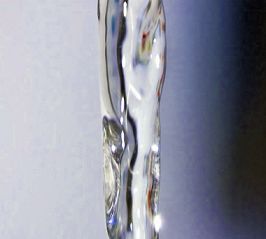Rinsing with Less Water
Introduction:
How important is rinsing? In the typical nickel-chrome line, it is not unusual to find three out of four tanks devoted to rinsing. This vital step after each process is necessary to:
- Stop the action of a chemical solution.
- Prevent the contamination of a subsequent process.
- Prevent chemical staining of the work.
 Good rinsing with small amounts of water has always been a sought after goal, but almost imperative in today's regulation dominated environment. Reducing the flow of water lessens the load on waste treatment systems and makes dragout recovery far more economical and practical.
Good rinsing with small amounts of water has always been a sought after goal, but almost imperative in today's regulation dominated environment. Reducing the flow of water lessens the load on waste treatment systems and makes dragout recovery far more economical and practical.
Rinsing is generally accomplished by immersing processed work in a tank of relatively clean running water. This results in the dilution of the residue on the work's surface. In a continuous processing line, the dilution ratio for a single rinse is easily calculated using the following formula:
Dilution ratio =
Drag-in (gph) + water flow (gph)
Drag-in (gph)
(We are using "gallons per hour", gph, as an easily handled unit of measurement.)
The rinse ratio number can be used to determine the concentration of any of the dragin components in this rinse tank.
Example:
Nickel plated parts are rinsed in a single tank of running water. Dragout from the nickel tank is estimated at 1 gph, water flow through the single rinse is 2,000 gph. The nickel metal concentration in the process tank is 10 oz/gal.
Dilution ratio =
1 gph drag-in + 2,000 gph water
1 gph drag-in
2001 |
= 2,001:1 |
Nickel metal concentration in the rinse tank is
10 oz per hour drag-in |
= 0.005 oz/gal |
Here we should note:
- The generally accepted level of contamination in the final rinse is 0.005 oz/gal metal or cyanide or 0.002 oz/gal chrome metal.
- The 2,000 gph to the rinse tank in the example is an unacceptably high flow rate.
THE MAGIC OF COUNTERFLOW RINSING
The only purpose for counter-flowing rinses is to conserve water. By increasing from one to two rinses, a water savings of 20 to 100 times is realized. In the nickel rinsing example above, 2,000 gallons per hour of rinse water is needed to maintain the low nickel concentration of 0.005 oz/gal in one rinse tank. The same rinsing (dilution ratio) can be accomplished with:
2 counter-flowing rinses and 44 gph flow rate, OR
3 counter-flowing rinses and 12 gph flow rate, OR
4 counter-flowing rinses and 6.4 gph flow rate.
Although a small amount of dilution occurs in each rinse tank, the multiplication of these ratios produces a high total. The formula for the rinse ratio in a multiple counter-flow arrangement is:
|
||||||||||||||||
Where "RW' is rinse water, "DO" is dragout (both are in gph), and "n" is the number of rinses.
An easier way to closely approximate the rinse ratio is:
|
MORE PRACTICE:
The dragout from a 32oz/gal decorative chrome bath is estimated at 1 gph. Chromic acid is about 52% metal; the actual metal content is about 16 oz/gal in this bath. In a triple counter-flow rinse system, the third rinse should have no more than 0.0O2 oz/gal metal. This requires a rinse ratio of 8,000:1.
| 16oz/gal | = 8,000 |
| 0.002oz/gal |
Fooling around with a pocket calculator, the cube root of 8,000 is 20.
20 x 20 x 20 = 8,000
With 20 gph water flowing through the three counter-flowing rinses, the rinse ratio is about 8,000:1. Each rinse dilutes the dragout to about 1/20 of the concentration of the previous tank (Rinse 1 is 1/20 of the process bath; Rinse 2 is 1/20 of Rinse 1; Rinse 3 is 1/20 of Rinse 2).
Most of us are accustomed to seeing much larger rinse ratios with triple counter-flow rinses operating at flow rates of 5 gallons per minute or 300 gph. If the dragout volume is 1 gph, then there is an approximate dilution of 300:1 in each of the three rinses, or 27,000,000:1 total! This would put the metal concentration in the chrome example at 0.0000006oz/gal in the last rinse, or more than 3,000 times cleaner than necessary. Nice, but very costly in water usage.
Table i. Rinse Water Requirements
Dragout Concentration (oz/gal) |
Rinse Water Requirements |
|||||
Chrome Metal |
Other Metals |
One Rinse |
2 |
3 |
4 |
5 |
| 1 | 2.5 | 500 | 22 | 8 | 4.4 | 3.2 |
| 2 | 5.0 | 1,000 | 32 | 10 | 5.4 | 3.7 |
| 4 | 10.0 | 2,000 | 44 | 12 | 6.4 | 4.3 |
| 8 | 20.0 | 4,000 | 63 | 16 | 7.7 | 5.0 |
| 16 | 40.0 | 8,000 | 89 | 20 | 9.2 | 5.8 |
| 32 | 80.0 | 16,000 | 126 | 25 | 11 | 6.7 |
*For 2 gph dragout, multiply by two, for ½ gph multiply by 0 .5, etc.
Table I shows the water requirements for one gallon dragout of various concentrations and for various numbers of rinses. These flow rates will result in a final rinse concentration of O.OO2 oz/gal chrome metal or 0.005 oz/gal other metals (nickel, zinc, etc.). This table illustrates several important points:
- Rinse water requirements increase in direct proportion to dragout volume, regardless of the number of rinse stations.
- Rinse water requirements for a single rinse station increase in direct proportion to dragout concentration.
- Rinse water flow rate requirements drop off dramatically with the addition of counterflow rinse stations.
- In this table, the greatest change in flow rate is between one and two rinses; the smallest change is between 4 and 5 rinses.
- When using multiple counter flowing rinses, it is more beneficial to reduce dragout volume than dragout concentration.
All these figures and calculations depend on the complete mixing of the dragout (or dragin) with the water in each rinse station.
AIR AGITATION
One way to achieve good mixing of rinse water and dragin is to use air agitation to keep the water in motion within the rinse tank. Place the air agitation pipe across the bottom of the tank and close to the wall or partition on the water inlet side. This will provide a rolling motion to the rinse water, pushing any floating films across to the discharge side of the tank.
When processing barrels or parts that entrap solution, special care in rinsing is required. It is important to flush out the interiors of barrels and entrapping parts with several immersions in each rinse station.
SPRAYS
Spray rinses can be added to the processing line to increase the number of counterflowing stations. Sprays may be positioned to rinse racked parts as they leave any rinse station or as they emerge from the plating or processing tank. Each set of sprays should be supplied with water pumped from the following rinse tank. There are two advantages of spraying over the final rinse tank: city water line pressure eliminates the need for a pump, and any overspray beyond the rinse tank is free of dragout. Pumps or city water pressure should be activated only when processed parts are actually in the spray zone. This will conserve water and allow the use of higher flow rate nozzles.
THE REAL WORLD
One large nickel-chrome plating shop cut their water consumption by a factor of 10. This was done by using several counterflowing rinses after each of the processes: cleaner, acid, nickel and chrome. This made evaporative recovery possible for all nickel and chrome dragout, with savings of chemical and waste treatment costs. More water was saved by re-using the acid rinse water in rinses after the cleaner.
Conclusion
Taking a little time to study your rinsing needs, and devising ways to minimize water usage will pay great dividends.
This article was re-printed from Metal Finishing Magazine as originally written by the inventor of the ET-III-W Evaporator.

